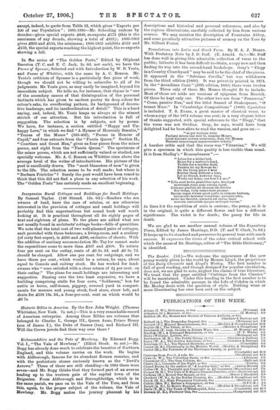Translations into Latin and Greek Verse. By H. A. J.
Munro. With Prefatory Note by J. D. Duff. (E. Arnold. 6s.)—Mr. Duff has done well in giving this admirable collection of verse to the public ; hitherto it has been difficult to obtain, a copy now and then finding its way into the second-band bookshops. Gray's " Elegy in a Country Churchyard " may be said to be the chief of the pieces. It appeared in the " Sabrina° Corolla," but was withdrawn from the third edition (1869). It was privately printed in 1874. In the "Arundines Cami" (fifth edition, 1860) there were twelve pieces. Three only of these Mr. Munro thought fit to include. Most of those set aside are versions of epigrams from Herrick. Of these he kept only one. The other two are from " Pensoroso," "Come, passive Nun," and the 101st Sonnet of Shakespeare, " 0 truant Muse." In "Cambridge Compositions" (1899) Cytnbeline is included. T. S. Evans, a great master of classical verse, to whom a copy of the 1874 volume was sent, in a very elegant letter of thanks suggested, with special reference to the "Elegy," that the verse was not Ovidian. Gray, he says, would have been delighted had he been alive to read the version, and goes on "at per vestigia yetis
Paeligni minus isse reor to, maxima Munro, quern signasse novum sermonem, dam tibi Musam Nasonis numerosque repraesentare videris."
A harsher critic said that the verse was " Vitruvian." We will give a specinien in which this quality is less visible than usual. It is from Shelley's " Remembrance " :— 4. Lilies for a bridal bed,
Roses for a matron's head, Violets for a maiden dead, Pansies let my flowers be : On the living grave I bear Scatter them without a tear, Let no friend, however dear, Waste one hope, one fear for me."
"Lilia aunt lectia genialibus apta, decotque matronale rosis nem corona ca put, Cumque puellari sit idoneus ille feretro Sos violas, viola versicolore prewar : Sparge super vivum quod porto in corpora bustum, spargendo lacrimas comprime, quisquis ades, nemo me decoret, quamvis eat cares, maul muuere, amicorum speque metuque vacom."
In lines 3-4 the repetition of viola is curious ; the pansy, as it is in the original, is quite a different flower and has a different significance. The violet is for death ; the pansy for life in death.














































 Previous page
Previous page